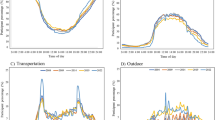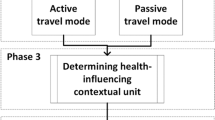Abstract
Information on human time-activity patterns is often required to interpret environmental exposure data fully and to implement exposure assessment models. Data on short-term time-activity patterns for individuals, such as 1-day measurements, are relatively abundant. The reliability of such data for use in chronic exposure (e.g., 1 or more years) assessments performed for evaluation of health risks is not well understood. As part of the NHEXAS-Maryland investigation, daily time budget data for seven microenvironments were collected from 80 people during as many as six 1-week Cycles over a 12-month period. The data were summarized and analyzed statistically by sampling Cycle, day of week, and individual to characterize long-term average microenvironmental time budgets and to identify their determinants. Median times spent in transit, indoors at home, outside at home, indoors at work or school, outdoors at work or school, indoors at other locations, and outdoors at other locations were found to vary significantly, although not substantively in many cases, by time of year (i.e., Cycle), by day of week, and by individuals. Time budgets for most of the microenvironments also exhibited significant variability by gender, age group, education level, annual household income, and work status. The results indicate that short-term (e.g., 1-day) measures of microenvironmental time budgets for individuals are unlikely to be representative of their long-term patterns. Thus, health risk or epidemiological assessments performed for a population mean or specific quantile may be relatively insensitive to when time budget data were collected. However, the accuracy of such assessments performed for individuals is likely to be greatly improved by collection of time budget data from numerous points in time.
This is a preview of subscription content, access via your institution
Access options
Subscribe to this journal
Receive 6 print issues and online access
$259.00 per year
only $43.17 per issue
Buy this article
- Purchase on Springer Link
- Instant access to full article PDF
Prices may be subject to local taxes which are calculated during checkout
Similar content being viewed by others
Author information
Authors and Affiliations
Rights and permissions
About this article
Cite this article
ECHOLS, S., MACINTOSH, D., HAMMERSTROM, K. et al. Temporal variability of microenvironmental time budgets in Maryland. J Expo Sci Environ Epidemiol 9, 502–512 (1999). https://doi.org/10.1038/sj.jea.7500046
Published:
Issue Date:
DOI: https://doi.org/10.1038/sj.jea.7500046
Keywords
This article is cited by
-
Characterizing the impact of projected changes in climate and air quality on human exposures to ozone
Journal of Exposure Science & Environmental Epidemiology (2017)
-
Statistical properties of longitudinal time-activity data for use in human exposure modeling
Journal of Exposure Science & Environmental Epidemiology (2013)
-
Human exposures to PAHs: an eastern United States pilot study
Environmental Monitoring and Assessment (2013)
-
Feasibility of using web surveys to collect time–activity data
Journal of Exposure Science & Environmental Epidemiology (2012)
-
Use of the HS-PTR-MS for online measurements of pyrethroids during indoor insecticide treatments
Analytical and Bioanalytical Chemistry (2012)



